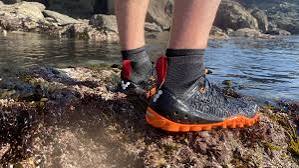Water shoes are a versatile and practical footwear choice for various aquatic activities and environments. Understanding their uses can help you make the most of these handy shoes. In this blog, we’ll explore what water shoes are, their primary uses, benefits, how to choose the right pair, and tips for care and maintenance.
Primary Uses of Water Shoes
Beach Activities
Water shoes are perfect for beach outings, offering protection from hot sand and sharp objects like shells or rocks. Their rugged soles provide grip on uneven surfaces, making walking on the beach safer and more comfortable.
Pool Use
In pools, water shoes help prevent slips on wet, slippery surfaces. They provide a non-slip grip and protect your feet from poolside abrasions.
Water Sports
For activities such as kayaking, paddleboarding, or rafting, water shoes are essential. They offer stability and traction on wet surfaces, helping you stay balanced and secure.
Hiking and Trail Walking
Water shoes are also beneficial for hiking in wet or muddy conditions. Their quick-drying properties and traction make them suitable for uneven and slippery trails, reducing the risk of slipping and improving overall comfort.
Benefits of Wearing Water Shoes
- Foot Protection
- Traction and Stability
- Quick Drying
- Comfort and Flexibility
When to Use Water Shoes
Water shoes are ideal for various activities, including beach outings, swimming pool visits, water sports, and hiking in wet conditions. They are most effective in environments where foot protection and slip resistance are necessary.
How to Choose the Right Water Shoes
Fit and Sizing
It’s essential to choose water shoes that fit snugly but comfortably. They should offer a secure fit without being too tight, allowing for adequate foot movement while preventing blisters.
Material Considerations
Select water shoes based on the activities and environments you’ll encounter. Neoprene and mesh are great for quick drying and flexibility, while rubber soles provide durability and traction.
Features to Look For
When selecting water shoes, consider features such as drainage holes, grip patterns, and arch support. Water shoes from reputable brands often offer these features to enhance performance and comfort.
Care and Maintenance
Cleaning Tips
After use, rinse your water shoes with fresh water to remove sand and debris. For deeper cleaning, use mild soap and a soft brush, then rinse thoroughly to avoid any build-up.
Drying and Storage
Allow your water shoes to air dry completely before storing them. Avoid direct sunlight and high heat, which can damage the materials. Proper drying and storage will extend the life of your shoes.
Conclusion
Water shoes are a valuable addition to your gear for aquatic activities and wet environments. By understanding their uses and benefits, you can choose the right pair to suit your needs. Whether you’re at the beach, pool, or on a muddy trail, water shoes provide the protection, traction, and comfort you need.

